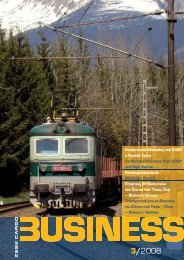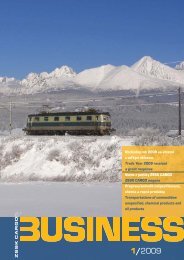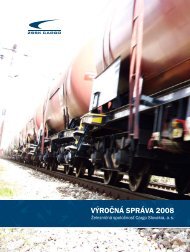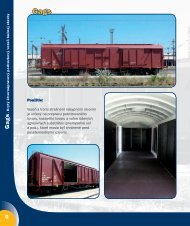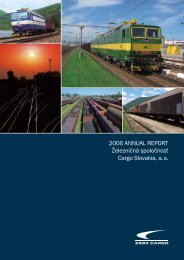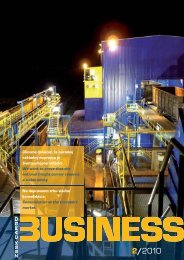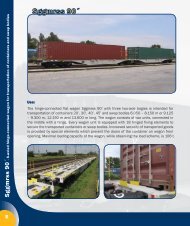CARGO BUSINESS 1-10.indd - ZSSK Cargo
CARGO BUSINESS 1-10.indd - ZSSK Cargo
CARGO BUSINESS 1-10.indd - ZSSK Cargo
- No tags were found...
Create successful ePaper yourself
Turn your PDF publications into a flip-book with our unique Google optimized e-Paper software.
múzejných zbierkach<br />
Two-axled wagons for coal transportations<br />
Another part of the series on freight wagons will be dedicated to the<br />
second most common type of universal freight wagon in the past –<br />
two-axled coal wagons.<br />
It might be quite surprising, but this type of wagon was not typical<br />
for railroads from its beginnings. The first open freight wagons were<br />
used primarily to transport coaches and only as the time progressed,<br />
these wagons transformed into platform wagons. The real beginning<br />
of high-sided wagons use was due to the need to transport coal. It<br />
can therefore be assumed that major expansion of this wagon type in<br />
the territory of Slovakia occurred in the late 60´s of the 19th century.<br />
With regard to the strategic importance of coal industry, the number of<br />
these wagons grew quickly and they soon made up more than a third<br />
of the rolling stocks.<br />
Construction of the first wagons to transport coal reflected the<br />
customs of the mid 19th century - a wooden frame, wooden box,<br />
continuous rod, wooden flooring and wall cladding, axle base of about<br />
2.9 meters, loading length of about 5 m. Despite relatively small<br />
dimensions, the wagons had – with regard to a relatively high mass<br />
density of coal - a decent loading capacity - up to about 11 tonnes.<br />
Efforts to reach the firmest possible construction of wagon box,<br />
adopted to not very considerate handling, especially during loading of<br />
coarse substrate, has caused that already first wagons were equipped<br />
with characteristic structure of tipping doors with upper suspension<br />
or lowered double wing doors. These enabled to maintain, from<br />
the standpoint of firmness of wagon body structure, the important<br />
uninterrupted upper longitudinal rolling bond timber of the wagon<br />
sidewall.<br />
As with other freight wagons, simplified iron manufacturing in the<br />
60´s and 70´s of the 19th century resulted in replacement of wood by<br />
iron in base construction – at first only the string pieces, later also the<br />
other parts. It is quite interesting that already during the 80´s of the<br />
19th century the iron was used also in the body frame construction of<br />
coal wagons. These coal wagons were ahead of their time by almost<br />
15 years when compared to wagons of other type.<br />
At that time, the normal axle base of wagons reached 3.8 meters,<br />
loading length was almost 6 m and load capacity increased to 15<br />
tonnes. The second tipping doors appeared in the sidewalls. Two<br />
wagons in the collections of Slovak railway museum are typical for this<br />
period. The first of them can be found on the monument in the area<br />
of Žilina wagon repair workshop. This wagon was manufactured by<br />
Vagónka Kopřivnice in 1884. It is interesting because of its features,<br />
such as raised centres of front parts, which enabled to increase<br />
the loading volume of the wagon. The second dates back to around<br />
1906 and is a part of railway exhibition in the former depot Bratislava<br />
Východ.<br />
In the last years of the 19th century, development of wagons, used<br />
for coal transportations, continued with gradual replacement of<br />
tipping doors by sheet metal flaps, sliding on the horizontal bar above<br />
the discharge openings. Even before the World War I, the turnover<br />
all-metal front doors came into use; the loading capacity of wagons<br />
reached up to 20 tonnes, at axle base of 4 to 4.6 m. These types of<br />
coal wagons were produced for ČSD, in series of several thousand<br />
pieces, until 1929. One of them – dating back to 1921 – has been<br />
preserved in the museum repository in Bratislava, unfortunately in<br />
non-renovated state.<br />
Another important type of two-axle wagon for transportation of coal,<br />
operated by the Slovak railways, was the all-metal wagon of series Vtr,<br />
produced between 1946 – 1957, virtually by all Czechoslovak wagon<br />
works in series of tens of thousands. Wagons with a pair of sliding<br />
flaps in each sidewall and a new pair of demountable flap in their<br />
middle, with roller bearings, loading length of 8.7 m and axle base of<br />
6 m, had a loading capacity of up to 30 tonnes, which corresponded<br />
to the increase of permitted axial load on main rail tracks of<br />
Czechoslovak Railways to 20 tonnes. By their improvement, in<br />
particular by certain simplification, wagons of series Vte (currently Es)<br />
were manufactured by wagon works in Romania and former Yugoslavia<br />
between 1965 and 1974. Some of them are still in operation.<br />
Jiří KUBÁČEK<br />
Museum-documentation centre of ŽSR<br />
Photos – archive of MDC ŽSR<br />
46/47




